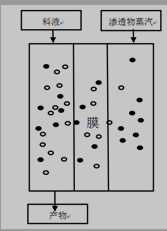- 上一篇:水热法制备石墨烯-壳聚糖-普鲁士蓝纳米复合材料
- 下一篇:3-羟基-γ-丁内酯的制备
摘 要:以聚乙烯中空纤维微滤膜为底膜,聚乙烯醇(PVA)和凹凸棒黏土(APT)为原料,采用溶液涂敷法,制备了不同APT含量的聚乙烯/聚乙烯醇-凹凸棒粘土渗透气化复合膜。对复合膜的物理化学结构进行了表征,并测试了复合膜的力学性能和溶胀性能。结果表明, PVA与APT两者通过氢键作用,改变了复合膜的溶胀性、力学性能,当APT含量5%时,复合膜的性能较好。57868
毕业论文关键词:聚乙烯醇, 凹凸棒粘土, 复合
Abstract: Polyethylene hollow fiber microfiltration membranes were selected as bottom film. Polyvinylalcohol and Attapulgite were selected as raw materials to prepare pervaporation composite membranes via solution coating method. The physical and chemical structures of the composite membranes were characterized, and the mechanical and swelling properties of the composite membranes were tested. The results revealed that PVA and APT were chemically bonded in the form of hydrogen bonds. Then, the swelling and mechanical properties of composite membranes were improved greatly. When the weight concentration of ATP was 5%,the composite membrane exhibited better properties in this work.
Keywords: Polyvinylalcohol, Attapulgite, Composite membrane
目 录
1 绪论 5
1.1 渗透汽化复合膜基本原理及其分类 5
1.2 渗透汽化复合膜的应用 5
1.3 聚乙烯醇 6
1.4 凹凸棒粘土 6
1.5 研究内容 7
2 聚乙烯-聚乙烯醇/APT纳米复合膜的制备 7
2.1 实验仪器与试剂 7
2.2 复合膜的制备 8
2.3 分析方法 8
2.4 结果与讨论 9
2.4.1 XRD分析 9
2.4.2 SEM分析 9
2.4.3 红外光谱分析 11
2.4.4 复合膜溶胀度性能分析 12
2.4.5 复合膜的力学性能分析 13
结 论 15
参考文献 16
致 谢 18
1 绪论
渗透汽化是一种新的膜分离技术,在液体混合物中利用各组分通过膜时溶解与扩散速度的不同,从而实现组分分离过程。与传统分离方法相比,具有能耗低、操作简单的特点。渗透汽化的主要应用有有机溶剂脱水,研究重点包括水醇体系[1]。
1.1 渗透汽化复合膜基本原理及其分类源[自-751^`论/文'网·www.751com.cn
目前渗透汽化的分离原理认为是溶解扩散过程。渗透汽化是液(气)体混合物分离的一种新的膜技术[2-4]。如图1所示,膜左侧气压一般为常压,右侧则维持很低的分压,这样在两边分压差的推动下,液料中的各组分通过膜,汽化为蒸气。冷却即可得到液体,从而达到浓缩分离的效果。
渗透汽化分离法适用于那些沸点相近、稳定性相近及同分异构体等。该技术使混合物的脱水、提纯,去污效果变得更好,所以渗透汽化膜分离技术值得广泛的推广。

-
凹凸棒土在油品脱色中的应用
-
聚乙烯醇凹凸棒粘土渗透汽化膜的制备与表征
-
TiO2-纳米凹凸棒石光催化膜制备研究
-
TiO2-纳米凹凸棒石中空纤维微滤膜制备
-
TiO2-纳米凹凸棒石陶瓷微滤膜制备研究
-
磁分离型凹凸棒土基复合...
-
TiO2-纳米凹凸棒石陶瓷微滤膜烧结工艺研究
当代大学生慈善意识研究+文献综述
大众媒体对公共政策制定的影响
乳业同业并购式全产业链...
河岸冲刷和泥沙淤积的监测国内外研究现状
杂拟谷盗体内共生菌沃尔...
酸性水汽提装置总汽提塔设计+CAD图纸
十二层带中心支撑钢结构...
java+mysql车辆管理系统的设计+源代码
电站锅炉暖风器设计任务书
中考体育项目与体育教学合理结合的研究